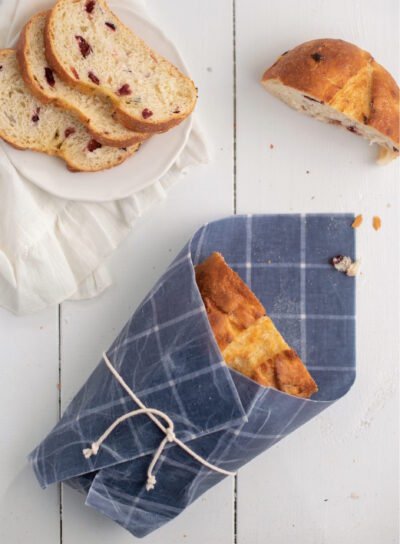#944 Food, flowers, and aspiration
Gather at Home: Over 100 Simple Recipes, DIYs, and Inspiration for a Year of Occasions
by Monika Hibbs
Toronto: Penguin Random House, 2020
$35.00 / 9780735236288
Reviewed by Jessica Poon
*
 Gather at Home by Monika Hibbs is undeniably picturesque in the most conventional way possible. Hibbs is a lifestyle influencer, a daring career choice after completing her MD; she is also a wife and mother, roles that characterize much of her output of Gather at Home. At times, the book feels more like an activity session for parents of young children. For instance, “Bobbing for Donuts” (p. 179) is perhaps the gastronomical, more exciting equivalent of pinning the donkey — donuts are suspended, and children try to eat them. Is it a clever, fun idea that would probably appeal to children? Yes. Is it what most people expect when they buy a book with 100+ recipes? Likely not, but perhaps fans of Hibbs are accustomed to incidental parenting advice.
Gather at Home by Monika Hibbs is undeniably picturesque in the most conventional way possible. Hibbs is a lifestyle influencer, a daring career choice after completing her MD; she is also a wife and mother, roles that characterize much of her output of Gather at Home. At times, the book feels more like an activity session for parents of young children. For instance, “Bobbing for Donuts” (p. 179) is perhaps the gastronomical, more exciting equivalent of pinning the donkey — donuts are suspended, and children try to eat them. Is it a clever, fun idea that would probably appeal to children? Yes. Is it what most people expect when they buy a book with 100+ recipes? Likely not, but perhaps fans of Hibbs are accustomed to incidental parenting advice.

Of course, Hibbs might be be appalled if I were to classify Gather at Home as merely a cookbook, for it is many things: a distillation of aspiration, accessible recipes, time-consuming recipes, and DIY crafts of varying usefulness, occasionally bordering on pointless. Unfaltering utilitarianism, of course, is dreary. Hibbs’s ethos is that presentation and little details matter — I agree; she writes that, “Although food is the main feature of most gatherings, it’s the little details that will truly elevate your guests’ experience” (p. 4). After all, you eat with your eyes. Time and time again, I am fundamentally irritated with people who say, for non-allergy reasons, “What’s in it?” before ever having a taste, people who reveal they do not trust their own tastebuds and are creating reasons to be wary. More than ever, to exude joy and concomitantly love in even seemingly infinitesimal ways, is of tangible value, which Hibbs clearly understands; however, making exceedingly ephemeral decorations, such as paper wrappers for ice cream cones, strikes me as oddly pointless. On the other hand, her suggestion for waxed fabric food wrap (p. 57) is aesthetically pleasing, and of far more reusable practical value than a paper wrapper for a melting dessert.

Hibbs is at her best when she concentrates on food, not purported crafts. For instance, her simple light cherry and heirloom tomato pasta dish (p. 96) with tomato, basil, red chile flakes, and pine nuts, is legitimately easy to prepare, requires few ingredients, and could easily be a mainstay in anyone’s cooking repertoire. The basil is fresh and the heat is moderate and pleasant. Did I mention, it’s legitimately easy? Although I steadfastly either avoid recipes with pine nuts or simply substitute with more affordable walnuts, I made the generally prohibitive expenditure for pine nuts, as indicated by her recipe, and I was rewarded — don’t forget to toast them.

The clean chocolate cupcakes (p. 39) taste more fun than their alliterative name might suggest; however, they are muffins in disguise, by which I mean, they are muffins, not cupcakes. They are dairy-free, egg-free, nut-free, and gluten-free. Although I’m no endorser of pretending that Medjool dates (the moment I see Medjool dates and realize they are the primary source of sweetness for a dessert, I become wary indeed) are anywhere as good as say, turbinado sugar, and nor do I like the idea of “good foods” and “bad foods” (or clean and unclean), as the widespread moralizing of food surely only increases the prevalence of body dysmorphic disorder, they fulfill their purpose well: providing a dose of chocolatey goodness. It’s a good recipe to have around if you have to bake for someone on a restrictive diet, or if you know a diabetic. I substituted the almond butter for the more pedestrian peanut butter and extra banana in lieu of an apple, to no discernible consequence. Having said that, after a bite of one of these sugar-free muffins, I was inspired to make an impromptu peanut butter frosting and found that the base of these muffins was perfect, preventing the peanut butter frosting from being too cloying by virtue of being relatively plain (and then they became, in my eyes, true cupcakes). Cream cheese with citrus zest would also work. The small amount of cinnamon in the recipe lingers in a manner reminiscent of gingerbread. Pleasantly, her Chocolate-Chip Cookies (p. 36) have a secret ingredient I’ll divulge: vanilla pudding. It’s probably one of the most novel chocolate-chip cookie recipes since Alison Roman’s audaciously officious recipe, simply known as “The Cookies.”
Hibbs writes about cabbage rolls and chicken soup in loving detail — she’s most in touch with her Polish cultural roots then. Much of her culinary commentary is centred towards whether husband or children like a dish, presumably because a nuclear family is a good barometer for what constitutes crowd-pleasing, children being notoriously idiosyncratic (i.e. picky).


Her kale Caesar with roasted chickpeas fills me with ambivalence — on the one hand, kale Caesars are perhaps the epitome of long-lasting fixation with kale as a superfood from which I myself am not exempt; in fact, it was one of the recipes I was most excited to try. The roasted chickpeas are like pleasantly spherical chips that would also be good if they were crushed like a powder; on the other hand, the actual dressing for the kale Caesar lacks panache, perhaps due to the omission of both anchovies and overall umami. The roasted chickpeas are a splendid addition, but the dressing is surprisingly lacklustre despite possessing acidity and much salt. To her credit, though, Hibbs does advise the reader to massage the kale, wisdom I thought was commonplace, but actually is not. For anyone who believes kale is overhyped bitter obligation, massage your kale until it is tender; until it sings with lemon and garlic and seasoning. Mix your kale with another brassica, or even better, mustard greens. As Bryant Terry writes in Vegetable Kingdom, “Bitter is an underappreciated flavor in the American palate” (p. 79) — he’s right. Eat your kale; throw in some chickpeas.
For a Vancouverite, which I consider to be a diluted version of an Angeleno in terms of fitness enthusiasm and infamous dietary restrictions, Hibbs leaves dietary restrictions and potential substitutions completely unaddressed, with many of her recipes featuring hearty amounts of butter, gluten, and/or eggs. That could be received as a delightful, old-fashioned throwback in the manner of French cuisine; on the other hand, it may suggest Hibbs is out of touch with a certain, sizeable audience; certainly, there is little to suggest that any of these recipes have unmarried, childless vegans in mind. Of course, anyone with dietary restrictions will have mastered the art of substitution even without explicit guidance from a cookbook, but the omission is noteworthy and incommensurate with modern food habits and is, as aforementioned, strange for a Vancouverite.
Hibbs’s Turkey Quinoa Burgers with Grilled Pineapple (p. 100) was a recipe I was immediately drawn toward. Although I recently learned that turkeys never reproduce naturally, which left me profoundly disturbed, my gravitation toward turkey remorsefully remains steadfast. Pineapple, of course, if consumed in vast quantities, leaves one’s tongue feeling fuzzy and for this precise quality, pineapple is well-suited, insofar that the very same enzyme also tenderizes meat gloriously. Pineapple with a beef burger is deservedly classic, but a turkey quinoa burger? It’s very omnivorously Vancouverite. (For a vegan alternative, try red lentils and mushrooms with quinoa). With avocado, tomato, cheese (I used a dairy-free simulacrum of cheddar), a wee bit of hot sauce, and on a brioche bun, it’s a filling, satisfyingly messy burger. My only suggestion would be, add bacon or crispy smoked eggplant stylized like bacon and maybe more hot sauce than the recipe indicates.

The photographs are stunningly beautiful. There are even spread-outs of various flowers and identifications, in the style of a botany dictionary, photographed tenderly; I was pleased to see lisianthus among them. The bouquets pictured seem to promise a lifestyle of rose-gold jewellery and white furniture bedecked photogenically with zeze plants; in fact, the bouquets seem to be the very epitome of aspiration itself — to easily afford ephemeral beauty; a pie is illustriously braided and obviously time-consuming; pumpkin waffles are reverently luscious; a quinoa bowl inspired by Asian flavourings — not explicitly mentioned but evident — is legitimately arresting with its cilantro garnish and fanned avocado. Often, I found my mouth watering while I flipped through the recipes, seized with a late night yearning for homemade peanut butter cups (p. 170) superior to even Reese’s Pieces. As I did not have mini muffin tin liners or mini muffin trays, I followed Hibbs’s recipe for Homemade Peanut Butter Cups and used a donut tray, resulting not in bite-size scrumptiousness, but enormous spheres of goodness. My God, were these richer and sweeter than even Reese’s. I finished half a litre of oat milk (every mention of almond milk in the recipe could easily be substituted with oat milk) afterwards, reverentially satisfied with the matchmaking glory of peanut butter and chocolate. The most important ingredient in the recipe is patience — allowing the cups to harden.
Although I attest that I am likely not Hibbs’s intended demographic, I still found much that was both pleasurable and palatable. Beautiful pictures of food are by no means rare, but they really are beautiful in Gather at Home, a worthwhile coffee table book not only for visual perusing, but to gather inspiration from.
*

Jessica Poon is a writer, line cook, and pianist in Vancouver. She recently completed her bachelor’s degree in English literature from the University of British Columbia. Visit her website here. She has recently reviewed books by Grant Hayter-Menzies and Wayson Choy for The Ormsby Review.
*
The Ormsby Review. More Books. More Reviews. More Often.
Publisher and Editor: Richard Mackie
The Ormsby Review is a journal service for in-depth coverage of B.C. books and authors. The Advisory Board consists of Jean Barman, Robin Fisher, Cole Harris, Wade Davis, Hugh Johnston, Patricia Roy, David Stouck, and Graeme Wynn. Scholarly Patron: SFU Graduate Liberal Studies. Honorary Patron: Yosef Wosk. Provincial Government Patron since September 2018: Creative BC
“Only connect.” – E.M. Forster